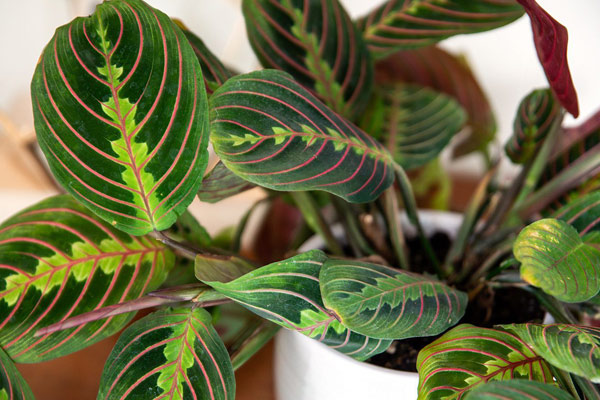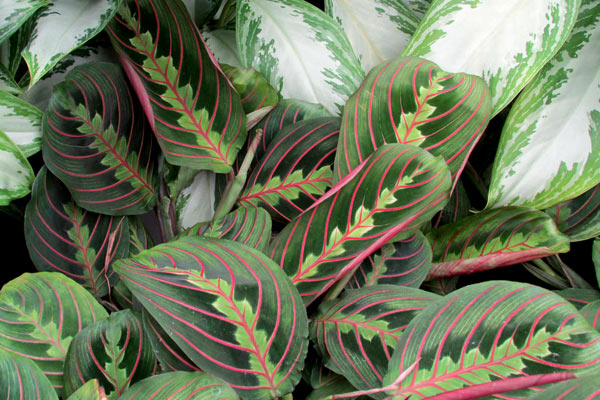Prayer Plant Care Guide (Maranta Plant)

Eye-catching foliage, bold veins, and easy care turn the prayer plant (maranta leuconeura) into a charming houseplant to grow. This plant has another unique feature as well, its leaves curl in the evening, resembling hands that are folded to pray. Prayer plant leaves curling is known as nyctinasty, creating an amazing effect in every space.
Scroll down for a full guide on prayer plant care and growing. But first, let us get to know this fascinating species better.
Maranta Leuconeura Info
As a member of the Marantaceae, some may confuse marantas with calatheas, which are also referred to as prayer plants. However, unlike prayer plants at night, calatheas leaves do not close in the evening.
A maranta plant has a more low-growing habit as well. For example, they spread across the forest floor in the wing, making them perfect plants to grow in hanging baskets or place on shelves.
These herbaceous perennials are native to the rainforests of Brazil, which gives you good clues about prayer plant care. In ideal condition (mostly when grown outdoors), you will be able to enjoy prayer plant flowers as well as their velvety leaves, white blooms that appear in the spring.
Prayer Plants Varieties
- Maranta leuconeura Marisela: Or simply Marisela prayer plant, this type features the same oval leaves, but has dark green with light-yellow veins that have a herringbone-like pattern.
- Maranta leuconeura erythrophylla: Also known as the herringbone plant, this tri-colored type is the most common variety featuring bold red veins.
- Maranta leuconeura kerchoveana: Also called Rabbit’s Tracks, this variety has plain green leaves with two rows of darker patches. Some may also refer to this type as the green prayer plant.
- Maranta leuconeura massangeana: This variety displays a darker background on its leaves with silvery patches along the midrib and white veins.
Is Prayer Plant Toxic to Cats?
Having a pet is no obstacle in decorating any space with this beautiful plant, as it is not toxic to cats. This plant is not poisonous in general and there is no known record of its toxicity.
Prayer Plant Benefits
These plants do not just elevate your decor or make excellent gifts (especially when you want to thank someone, as this plant symbolizes gratitude). A red prayer plant as well as other varieties help clear the air by filtering indoor air pollutants.

Prayer Plant Care
Although maranta leuconeura is easy-to-care, it has specific requirements. Continue to read to know them better and grow the healthiest red prayer plant!
Soil
This plant thrives in a variety of soils if they are well-draining and neutral to acidic. Available potting mixes in stores are suitable. You can also make the soil at home by mixing two parts of sphagnum peat moss, one-part loamy soil, and one part perlite together.
Prayer Plant Light
Maranta leuconeura needs indirect light. They also tolerate areas with lower light. So, it is a good idea to place your plant near a window and never in direct sunlight. Strong and direct light not only scorches the leaves but also causes them to develop brown patches and dulls their shiny color.
In the winter, when the maranta plant goes into dormancy, place them in a location with bright light to maintain growth.
Temperature and Humidity
Average household temperatures are ideal for prayer plant care but do not forget that prolonged lower temperatures can damage the leaves and even cause them to drop.
As evident by its natural habitat, this gorgeous plant grows best in (very) humid environments. To provide its preferred humidity, place a small humidifier near your maranta leuconeura, mist the leaves frequently using room temperature or slightly warm water, or place it atop a tray filled with pebbles and water.
Prayer Plant Watering
Maranta plant needs frequent irrigation during its growing season. During this period, you need to water it whenever the top layer of its soil is dry and never let the potting mix dry out. You need to avoid drought at all costs when it comes to prayer plant care, as this species will not survive if left without water.
Note: For prayer plant watering, use room temperature or slightly warm water.
Feeding
You can fertilize your plant every two weeks using a water-soluble houseplant fertilizer diluted to half-strength. Start feeding in early spring, continue until fall, and reduce to once a month by the winter.
Be careful when fertilizing. Because too little fertilizer will slow or completely stop the growth rate. Too much fertilizer would also burn the roots, causing its leaves to brown and even the maranta plant to die.
Note: In general, this species is considered a slow grower, growing up to 12 inches at their tallest.

Prayer Plant Problems
Prayer plant watering needs may make it susceptible to fungal problems. To prevent this, do not allow water to sit directly on the leaves or let the plant get soggy. Remember that both insufficient water and overwatering can cause the prayer plant problems like yellow leaves that eventually drop.
Additionally, maranta leuconeura, like many other houseplants, can be prone to aphids, spider mites, and mealybugs. If you see any infestation signs including white powdery substances on the leaves or foliage browning, treat your plant with natural insecticides like neem oil.
How To Propagate Prayer Plant
Prayer plant propagation is incredibly easy using the right method, which is to divide the plant while repotting. When repotting, gently shake the soil off the roots and divide the plant into several smaller plants.
Make sure that all the small red prayer plants have a good mass of roots and several stems. Then, pot them into individual shallow pots. During the first few weeks, keep them in a very warm and moist location until new growth emerges.
- In this post:
- Maranta Leuconeura Info
- Prayer Plant Care
- Prayer Plant Problems
- How To Propagate Prayer Plant



